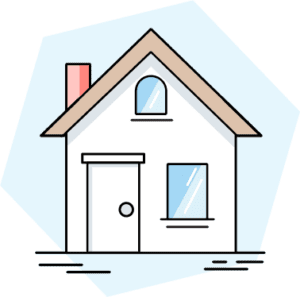An HO-2 policy is a type of homeowners insurance for people who live in single-family homes. It’s also known as a broad-form policy or 16-named perils insurance.
HO-2 home insurance covers damage to your home and belongings from 16 specific disasters, including fire, theft, and falling objects. Some policies also cover other structures on your property, help pay for additional living expenses if your home is uninhabitable, and/or include personal liability protection.
HO-2 policies are less popular than the more comprehensive HO-3s, but they’re still a good option for some homeowners. Read on for details about HO-2s work and when it makes sense to get one.
Table of Contents
How HO-2 Home Insurance Works

Homeowners who buy an HO-2 policy make regular payments, called premiums. In exchange, the insurance company agrees to help cover the cost of certain sudden and unpredictable events up to the policy’s limits.
HO-2 policies include both dwelling coverage and personal property coverage. Dwelling coverage is the part that helps you pay to repair or rebuild your home’s structure if it’s damaged or destroyed in a disaster. Personal property coverage helps you replace personal belongings, like furniture, appliances, and clothing.
Depending on the insurer and policy, HO-2 insurance may also include one or more of the following coverages:
- Other structures: Protects structures that are separate from your home. Some examples of other structures include sheds, fences, and detached garages.
- Personal liability: Helps pay for bodily injury or property damage that you’re found legally responsible for. For example, personal liability protects you if your dog bites a houseguest.
- Loss of use: Covers temporary living expenses while your home is being repaired. Eligible living expenses could include hotel stays, restaurant bills, and pet boarding.
- Medical payments: Helps pay for medical expenses if a guest is injured on your property. It’s designed to pay small bills quickly.
Coverages
An HO-2 policy covers damage to your home or belongings on a named-perils basis. That means it only covers damages caused by the specific events named in the policy. The 16 standard named perils are:
- Fire or lightning
- Windstorm or hail
- Explosion
- Riot or civil commotion
- Damage caused by aircraft
- Damage caused by vehicles
- Smoke
- Vandalism or malicious mischief
- Theft
- Volcanic eruption
- Falling objects
- Weight of ice, snow, or sleet (heavy winter weather)
- Sudden and accidental power surges
- Freezing of home systems or household appliances
- Accidental discharge of water or steam from a home system or household appliance
- Cracking, tearing, burning, or bulging of home systems
Exclusions
HO-2 home insurance only covers damages caused by the perils named in the policy. If an event is not listed, it’s not covered. Some common unexpected events that are excluded from HO-2 policies include:
- Flooding, including storm surges during hurricanes
- Earth movement, including earthquakes, mudslides, and sinkholes
- Water backups through a sewer or drain
- Pest infestations, such as termites
- Damage caused by negligence or poor maintenance
- Any other event not listed in the policy
Types of Home Insurance Policies
There are several different types of home insurance policies. The HO-1 offers basic coverage for a single-family home, while the HO-2 offers a higher level of coverage. Both HO-3 and HO-5 insurance cover a wider range of perils. Insurers also sell policies designed for condo owners, mobile homeowners, and people who rent their homes. Check the table below to compare home insurance types at a glance.
Home Insurance Form Categories | Dwelling Type | Named or Open Peril | Dwelling Coverage | Other Structures Coverage | Personal Property Coverage | Liability Coverage | Medical Payments Coverage | Loss of Use Coverage |
|---|---|---|---|---|---|---|---|---|
HO-1, or 10 Named Perils Insurance | Single-family home | Named | Yes | Varies | No | No | No | No |
HO-2, or 16 Named Perils Insurance | Single-family home | Named | Yes | Varies | Yes | Varies | Varies | Varies |
HO-3, or Standard Home Insurance | Single-family home | Open for dwelling, Name for personal | Yes | Yes | Yes | Yes | Yes | Yes |
HO-4, or Renter’s Insurance | Rental property | Named | No | No | Yes | Yes | Yes | Yes |
HO-5, or Open Perils Insurance | Single-family home | Open | Yes | Yes | Yes | Yes | Yes | Yes |
HO-6, or Condo Insurance | Condo, co-op, or townhome* | Named | Varies | No | Yes | Yes | Yes | Yes |
HO-7, or Mobile Home Insurance | Mobile home | Open | Yes | Varies | Yes | Yes | Varies | Yes |
HO-8, or Modified Coverage Home Insurance | Varies** | Named | Yes | Yes | Varies | Varies | Varies | Varies |
** Homes that are not eligible for standard home insurance policies; criteria may differ based on state and insurer
How Much Does HO-2 Insurance Cost?

In general, HO-2 insurance tends to have lower premiums than other types of homeowners insurance, such as HO-3 and HO-5 policies. That’s because it provides more limited coverage.
The actual cost of HO-2 insurance varies depending on many factors, but location is one of the most important. Some areas have a higher risk of perils like theft or natural disasters than others and the cost of the labor and materials needed to make repairs vary depending on the region.
The home itself is another key factor affecting the cost of HO-2 insurance. Larger, higher-value homes cost more to insure because they’re costlier to rebuild after a disaster. Other features, from fire-resistant building materials to water leak detection systems, can lower the cost of insurance.
A homeowner’s chosen coverage level also affects their coverage. Some policies pay to replace the home and possessions at their actual cash value, taking into account their age and condition. Other policies pay the replacement cost, meaning the cost of buying similar, new items. The latter costs more since it offers a higher coverage level.
Should You Consider an HO-2 Homeowners Policy?
HO-2 homeowners insurance policies offer basic, affordable coverage and may be a good option for some homeowners. Other people prefer a homeowners insurance policy that offers coverage for a wider variety of perils, even if it costs more.
To decide if HO-2 insurance makes sense for your individual situation, consider the following benefits and drawbacks of HO-2 policies.
- Lower premiums than other options
- Offers broad named perils coverage
- May be offered for higher-risk homes
- Only covers named perils
- Must prove the loss is covered
- Limited policy availability
Pros
- Lower premiums than other options: HO-2 insurance appeals to budget-conscious homeowners because its premiums are typically low compared to HO-3 and HO-5 insurance. By saving money on their policy, homeowners can unlock funds for other household needs.
- Offers broad named perils coverage: HO-2 homeowners insurance covers more perils than HO-1 insurance, a basic policy type available in some areas. A typical HO-2 homeowners policy covers 16 different named perils, while an HO-1 only covers 10.
- May be offered for higher-risk homes: Sometimes, insurance companies decline to sell a standard HO-3 policy for homes they see as high risk to insure for one reason or another. However, HO-2 coverage may still be available since insurers assume less risk with named-peril policies.
Cons
- Only covers named perils: HO-2 insurance only covers losses caused by an event specifically listed in the policy, such as fire or windstorm. If any other event damages your home or belongings, you’re responsible for paying for repairs out of pocket.
- Must prove the loss is covered: With an HO-2 policy, the burden of proof is on the homeowner to show that a covered event caused the damage. Be prepared to provide detailed documentation in the event of a claim, such as photos, videos, original receipts, and witness statements.
- Limited policy availability: HO-3 policies are the most popular type of homeowners insurance, so some insurers only offer this option. HO-2 coverage is less popular, and due to the lower demand, not all insurance companies choose to sell it.
Who Are HO-2 Policies For?

While HO-2 policies are less popular than other types of homeowners insurance, they’re still a good choice for some people. You may prefer an HO-2 if:
- You own a single-family home: The HO-2 is designed to cover single-family homes. Other policy options are available for people who own condos or mobile homes or rent their homes.
- You want protection from the 16 named perils: While HO-2 insurance covers fewer risks than some other policies, its named perils still represent some of the more common risks to homes, like theft and fires.
- You have a higher risk tolerance: With an HO-2 policy, homeowners pay the full cost of repairs for damages caused by perils not listed in the policy. Other policy options might have covered those damages.
- You prioritize having lower premiums: With lower premiums than some other policy types, HO-2 policies help homeowners save money upfront. However, the premiums are lower because the coverage is less comprehensive.
What This Means For You
HO-2 homeowners insurance helps you rebuild your home and replace your belongings after certain unforeseen events, like fires and windstorms. It offers basic, cost-effective protection that appeals to some homeowners.
Consider an HO-2 homeowners policy if you want to protect your single-family home from the 16 named perils but do not want to pay more for additional coverage. If you want broader coverage, ask your agent about other options, like the HO-3 or HO-5.
